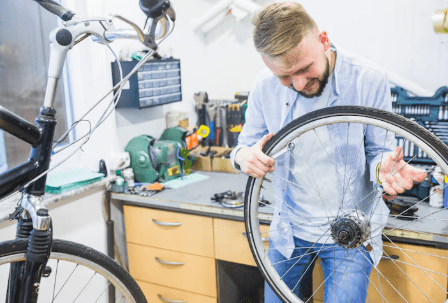In the context of the continuous evolution of bicycle technology, servo motors, with their characteristics of high-precision control, fast response, and stable output, are emerging as key components driving bicycle innovation. From riding assistance and safety protection to personalized experiences and intelligent interaction, servo motors can break the functional boundaries of traditional bicycles, bringing users a more efficient, safe, and convenient riding experience. The following elaborates on the innovative ideas of servo motors in the bicycle field from six core directions.
- Intelligent Riding Assistance: Dynamic Adjustment for Scenario Adaptation
The precise torque control capability of servo motors enables dynamic adaptation to different riding scenarios, addressing the “one-size-fits-all” pain point of traditional bicycles.
- Adaptive Shifting System: Traditional bicycles require manual shifting, which makes it difficult to accurately match road conditions. By integrating servo motors into the shifting mechanism and combining data from speed sensors and slope sensors, real-time automatic shifting can be achieved. For example, it automatically switches to a low gear when going uphill to reduce pedaling resistance; shifts to a high gear during flat-road cruising to improve riding efficiency; and adjusts to an appropriate gear when going downhill to avoid chain idling. The millisecond-level response speed of servo motors ensures seamless shifting, preventing riding rhythm disruption caused by shifting jams.
- Dynamic Power Assistance Adjustment: For electric-assist bicycles (E-Bikes), servo motors can replace traditional mechanical power-assist switches. By analyzing the rider’s pedaling force and frequency, they dynamically adjust the power assistance ratio. For instance, when it detects insufficient force from the rider, the servo motor can accurately increase the motor’s assist torque; when the rider actively accelerates, it automatically reduces the proportion of power assistance, which not only saves power but also retains the rider’s sense of control. In addition, for different groups of people (such as the elderly and children), power assistance modes can be preset via an APP, and the servo motor executes differentiated power assistance output.
- Safety Protection Upgrade: Proactive Risk Avoidance
The controllable advantage of servo motors can be transformed into the active safety protection capability of bicycles, reducing collision risks during riding.
- Intelligent Steering Assistance: In scenarios such as sharp turns and lane changes, novice riders or those who are fatigued tend to have problems with excessive or insufficient steering angles. By installing a servo motor at the handlebar steering shaft and combining data from a gyroscope and a camera (which identifies lane lines and obstacles), when a steering risk is detected, the servo motor can apply a slight reverse torque to assist in correcting the steering angle. For example, when it is about to deviate from the lane, it automatically makes a slight adjustment toward the inside of the lane to avoid collisions with roadside obstacles or other vehicles.
- Automatic Braking Assistance: When sensors (such as millimeter-wave radar and visual sensors) detect sudden obstacles ahead (such as pedestrians crossing the road or the vehicle in front braking suddenly) and the rider fails to brake in time, the servo motor can link with the braking system to achieve graded braking assistance. If the distance is still far, the servo motor drives the brake lever to apply slight braking to remind the rider; if the distance is too close, it directly applies the maximum safe braking force, while preventing wheel lock-up caused by sudden braking (by adjusting the servo motor torque in real time to control the braking force).
- Folding and Portability: Efficient Space Optimization
The core pain points of folding bicycles are “cumbersome folding steps and insecure locking”. Servo motors can simplify the folding process through automatic control and improve structural stability.
- Automatic Folding System: Install servo motors at the folding joints (such as the middle of the frame, the connection between the handlebar and the frame, and the wheel bracket). Users only need to press a button, and the servo motor can complete the folding action according to a preset program. For example, it first reduces the handlebar height, then folds the frame in half, and finally retracts the wheel bracket. The entire process requires no manual effort and has higher folding precision (the servo motor can accurately control the joint angle, avoiding structural deviations caused by manual folding).
- Intelligent Locking and Unlocking: After folding, the servo motor can automatically drive the lock component to firmly lock the folding joint, preventing accidental loosening during riding or carrying. When unfolded for use, after receiving the unlocking command, the servo motor quickly unlocks the lock and assists in unfolding the frame to ensure that all components are accurately reset (such as the handlebar being level with the frame and the wheels aligned with the frame), avoiding riding safety hazards caused by incomplete manual unfolding.
- Personalized Experience: Customized Riding Adaptation
Different users have significant differences in riding habits and physical conditions. Servo motors can realize personalized adjustment of bicycle parameters to meet diverse needs.
- Adjustable Riding Posture: By integrating servo motors into the seat lifting rod and the handlebar angle adjustment mechanism, users can adjust the seat height, the front-rear distance of the handlebar, and the tilt angle in real time through an APP or a handlebar controller. For example, during long-distance riding, raising the seat and straightening the handlebar reduces waist pressure; during racing riding, lowering the seat and pressing down the handlebar reduces wind resistance. The precise control of the servo motor enables millisecond-level adjustment, ensuring that the posture is adjusted to the most comfortable state.
- Customized Shock Absorption Feedback: For the shock absorption system of mountain bikes, servo motors can dynamically adjust the hardness of the shock absorber based on road conditions (such as bumpy roads and smooth roads) and the rider’s weight. For example, when the sensor detects a bumpy road, the servo motor increases the damping of the shock absorber to improve the shock absorption effect; when the rider is relatively heavy, it automatically stiffens the shock absorber to avoid shock absorption failure caused by excessive compression while maintaining the support during riding.
- Intelligent Interaction: Connecting Multi-scenario Ecosystems
In the era of the Internet of Things, servo motors can serve as “execution terminals” for the interaction between bicycles and external devices, realizing more intelligent scenario linkage.
- Automatic Adjustment Driven by Riding Data: Combined with data from smart bracelets, heart rate monitors, and other devices, servo motors can achieve adaptive adjustment. For example, when it detects that the rider’s heart rate is too high (in a fatigued state), it automatically lowers the threshold of electric assistance to reduce the rider’s effort; when it detects that the rider is in a sports mode (heart rate maintained in the aerobic range), it appropriately increases riding resistance (by adjusting the shifting or braking system through the servo motor) to improve the sports effect.
- Multi-device Linkage Control: When the bicycle is connected to the mobile phone via Bluetooth, the servo motor can be controlled to perform operations through voice commands. For example, saying “Start folding” activates the automatic folding program of the servo motor; saying “Adjust seat height” automatically adjusts the seat according to the preset height parameters. In addition, in smart city scenarios, if the bicycle is connected to the traffic Internet of Things, when receiving a signal that “the traffic light ahead is red”, the servo motor can apply slight braking in advance to remind the rider to slow down and stop.
Established in 2005, Kpower has been dedicated to a professional compact motion unit manufacturer, headquartered in Dongguan, Guangdong Province, China. Leveraging innovations in modular drive technology, Kpower integrates high-performance motors, precision reducers, and multi-protocol control systems to provide efficient and customized smart drive system solutions. Kpower has delivered professional drive system solutions to over 500 enterprise clients globally with products covering various fields such as Smart Home Systems, Automatic Electronics, Robotics, Precision Agriculture, Drones, and Industrial Automation.

































